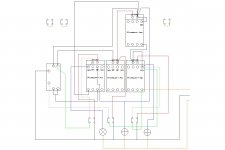Hi,
I'm mainly looking to pick brains here. I'll try and be as clear as possible but pretty much just brainstorming at the mo...
My available power supply is ~240VAC Line-Neutral (1ph).
I have a number of 3ph motors I'd like to make use of, ranging from 380, 400, 420, 440 etc. One of these is dual wound(?) for "220/240 - 380/420"
I could potentially use it as an RPC, however I'm guessing that putting 240 in will not generate 440 out?
OR is it likely that it would be wired in such a way that If I carried the the 240 legs through, the generated leg would also be at 240, giving me 480 line-line? How can I test this (without putting power to it and letting the smoke out(‽))
Follow up question - would it be safe to swap legs on this output to provide 3ph reverse on driven motors?
The second question I have concerns a 3ph transformers - I was looking at a 400-240 reducing 3ph transformer.
Could this be wired "backwards" and with the phases/coils split, ie 240 -> 480, then wire that to the next coil for 480 -> 960 and to the next 960 -> 1920?
Thirdly, to kind-of combine the above, if I run my dual-wound at 240 as an RPC to get 3ph 240, then "backwards" through the 3ph transformer to go from 3ph 240 to 3ph 440 and then can run all the other motors from the transformer output.
And finally, am I fairly safe in provididng ~480VAC to a 380 rated motor? surely more voltage = less current = less heat = more torque(?)
I should mention I'm in New Zealand, and I'm not on speaking terms with OSH, so I'm looking for a working(safe) solution, if not entirely code compliant.
Cheers for your time.
I'm mainly looking to pick brains here. I'll try and be as clear as possible but pretty much just brainstorming at the mo...
My available power supply is ~240VAC Line-Neutral (1ph).
I have a number of 3ph motors I'd like to make use of, ranging from 380, 400, 420, 440 etc. One of these is dual wound(?) for "220/240 - 380/420"
I could potentially use it as an RPC, however I'm guessing that putting 240 in will not generate 440 out?
OR is it likely that it would be wired in such a way that If I carried the the 240 legs through, the generated leg would also be at 240, giving me 480 line-line? How can I test this (without putting power to it and letting the smoke out(‽))
Follow up question - would it be safe to swap legs on this output to provide 3ph reverse on driven motors?
The second question I have concerns a 3ph transformers - I was looking at a 400-240 reducing 3ph transformer.
Could this be wired "backwards" and with the phases/coils split, ie 240 -> 480, then wire that to the next coil for 480 -> 960 and to the next 960 -> 1920?
Thirdly, to kind-of combine the above, if I run my dual-wound at 240 as an RPC to get 3ph 240, then "backwards" through the 3ph transformer to go from 3ph 240 to 3ph 440 and then can run all the other motors from the transformer output.
And finally, am I fairly safe in provididng ~480VAC to a 380 rated motor? surely more voltage = less current = less heat = more torque(?)
I should mention I'm in New Zealand, and I'm not on speaking terms with OSH, so I'm looking for a working(safe) solution, if not entirely code compliant.
Cheers for your time.




 ) it came up dead-short.
) it came up dead-short.